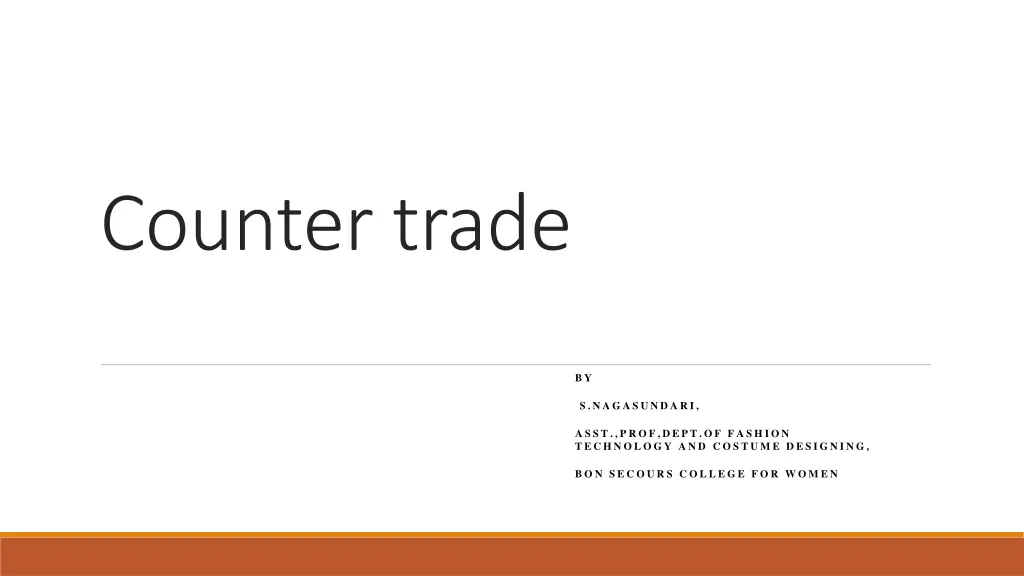
Understanding Countertrade: Types and Examples
Explore the concept of countertrade, a reciprocal form of international trade where goods or services are exchanged instead of currency. Learn about the main types such as barter, compensation deals, counter purchase, and buyback, along with examples showcasing how it is utilized in trade relationships between nations. Discover the significance of countertrade in developing countries with limited foreign exchange resources and its role in controlling trade and aiding development strategies.
Download Presentation

Please find below an Image/Link to download the presentation.
The content on the website is provided AS IS for your information and personal use only. It may not be sold, licensed, or shared on other websites without obtaining consent from the author. If you encounter any issues during the download, it is possible that the publisher has removed the file from their server.
You are allowed to download the files provided on this website for personal or commercial use, subject to the condition that they are used lawfully. All files are the property of their respective owners.
The content on the website is provided AS IS for your information and personal use only. It may not be sold, licensed, or shared on other websites without obtaining consent from the author.
E N D
Presentation Transcript
Counter trade B Y S . N A GA S U N D A R I , A S S T . , P R O F ,D EP T.O F F A S H I O N TEC H N O LO GY A N D C O S TU M E D ES I GN I N G, B O N S EC O U R S C O LLEGE F O R W O M EN
INTRODUCTION Trading between nations has been happening since time began. In ancient time nations traded silk, spices, cloth and animals of all kinds. Today nation trade food items, defense equipment, metals, electronics etc. The products might have changed but the basic concept is still the same as the underlining need which brings together two nations in a trade relationship still exists. One such method of trading between nations is called counter trade.
COUNTER TRADE Countertrade is a reciprocal form of international trade in which goods or services are exchanged for other goods or services rather than for hard currency. This type of international trade is more common in developing countries with limited foreign exchange or credit facilities. Countertrade is often used when a foreign currency is in short supply or when a country applies foreign exchange controls, which are limits imposed on the availability of foreign currencies to importers for the purchase of foreign products. Countertrade is often used by developing countries to control trade and as a development technique.
TYPES OF COUNTER TRADE There are main 4 types of counter trade. They are as follows, Barter Compensation deals Counter purchase Buyback
BARTER TRADE Bartering is the oldest countertrade arrangement. It is the exchange of goods and services for goods and services without any use of money. Like the trade relationship between China and Thailand where fruit has been traded by Thailand for buses made by China.
COMPENSATION DEAL A type of countertrade that involves the exports of goods in one direction. The payment of the goods is split into two parts: Part payment in cash by the importer. For the rest of the payment the original exporter makes an obligation to purchase some of the buyer s goods. The products of the compensation deal can be used in the exporter s internal production or they may be sold on in the wider market.
COUNTER PURCHASE Acounterpurchase refers to the sale of goods and services to a company in a foreign country by a company that promises to make a future purchase of a specific product from the same company in that country.
BUYBACK Abuyback is a countertrade occurs when a firm builds a manufacturing facility in a country or supplies technology, equipment, training, or other services to the country and agrees to take a certain percentage of the plant's output as partial payment for the contract.




